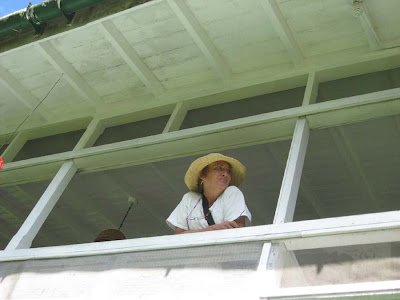Before leaving Trinidad last month, we took a day off from boat chores
to check out a couple of nature attractions.
Meet Jesse James, our tour guide and driver for the day.
Jesse’s the guy to call.
Before getting properly underway, Jesse stopped to get us a snack of doubles. He couldn’t believe we’d been in Trinidad for over a month and hadn't tried one.
 Doubles are an East Indian specialty - street food served up with a beer - morning, noon, and night. Two bara (flat fried breads) are filled with curried channa (chick peas). At $3TT - about fifty cents - the price is certainly right.
Doubles are an East Indian specialty - street food served up with a beer - morning, noon, and night. Two bara (flat fried breads) are filled with curried channa (chick peas). At $3TT - about fifty cents - the price is certainly right.Do NOT ask for extra pepper topping.
Our route took us through Port of Spain
– actually all routes to just about anywhere go through Port of Spain.
As we drove further out of the city ……
As the towns thinned out, the rain forest started to close in.
The Asa Wright Nature Centre (www.asawright.org) covers nearly 1,500 acres in the Northern Mountain Range of Trinidad. The former Spring Hill Estate, a privately owned cocoa-coffee-citrus plantation, was ceded to a not-for-profit trust in 1967. It’s now a world-renowned nature and birding destination. There are guided walks or you can hike on your own through the rainforest. The main plantation house is now a restaurant with a huge verandah for relaxing and bird-watching, and the outbuildings have been converted into modest accommodation.
We did a nature walk with Barry, our guide. He shared his extensive knowledge of the rainforest – the birds, the trees, the plants and flowers.
 This is a Butterfly Orchid -
This is a Butterfly Orchid -
 This is a Butterfly Orchid -
This is a Butterfly Orchid -Monkey vines are everywhere.
 They’re sculptural and fascinating to look at, but very deadly. They increase in girth and strength as they grow around other vegetation and eventually choke it out. At the Asa Wright Nature Centre, the rain forest is left to its natural cycle – nothing is cut down or moved.
They’re sculptural and fascinating to look at, but very deadly. They increase in girth and strength as they grow around other vegetation and eventually choke it out. At the Asa Wright Nature Centre, the rain forest is left to its natural cycle – nothing is cut down or moved.Termite nests are everywhere as well but not as interesting to look at.
 Since they only eat dead wood, the termites are left to do their part
Since they only eat dead wood, the termites are left to do their part
 Since they only eat dead wood, the termites are left to do their part
Since they only eat dead wood, the termites are left to do their part of the growth and regrowth cycle.
After an hour and a half of wandering along the rough trails,
we headed back to the main building for lunch.
 We shared a good local meal with other visitors at a huge communal table, then spent a bit of free time on the verandah ......
We shared a good local meal with other visitors at a huge communal table, then spent a bit of free time on the verandah ......
to capture great pictures of the birds.
 This little hummingbird, not much bigger than a butterfly, was a brilliant iridescent blue. (http://www.hummingbirds.net/)
This little hummingbird, not much bigger than a butterfly, was a brilliant iridescent blue. (http://www.hummingbirds.net/) Trinidad’s original name in the native Arawak language was “lere”,
meaning “Land of the Hummingbird”.
The last stop of the day was the Caroni Swamp on the west coast.
(www.traveladventures.org/continents/southamerica/caroni.shtml)
It encompasses 15,000 acres of marshland with three kinds of mangroves, red, white and black – coincidentally the colours of the Trinidad and Tobago flag.

It encompasses 15,000 acres of marshland with three kinds of mangroves, red, white and black – coincidentally the colours of the Trinidad and Tobago flag.

gradually turns the feathers red.
The birds return by the thousands and land on their nighttime roosting island.
By law, the tour boats are not allowed to get any closer to the action than a quarter of a mile.
Trinidad is a big island at close to 2,000 square miles.
Our nature tour barely covered the top fifth of the country.
Our nature tour barely covered the top fifth of the country.
but we’re glad we had one particularly fine day checking some of it out.



















No comments:
Post a Comment